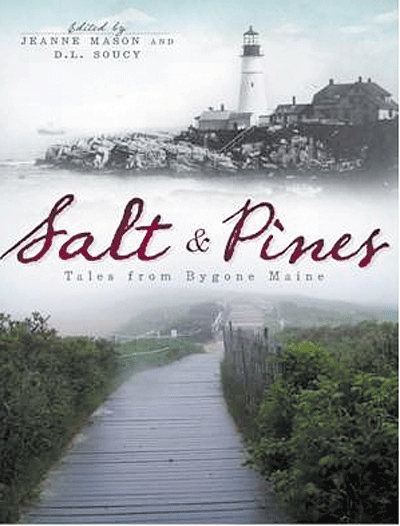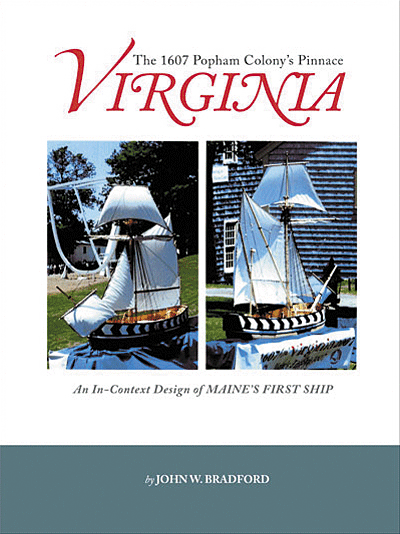SALT & PINES: TALES FROM BYGONE MAINE
Edited by Jeanne Mason and D.L. Soucy
The History Press, 2011, 192 pages, $19.99
ISBN 978-1-60949-368-4
Jeanne Mason and D.L. Soucy have a good idea. They are collecting stories about “what it was like to live in Maine’s bygone days,” capturing vivid memories while aging folks are still around to tell tales of logging, fishing, farming and growing up in the 1920s-50s.
The 31 essays and poems in SALT & PINES are provided by 19 contributors, all Mainers — some natives, some transplants. These men and women are clearly eager to share their stories, before such colorful and delightful memories evaporate with time and age.
Mason spent her summers in Maine, and Soucy was born and raised in Maine. Both are accomplished writers.
In “Promise Made, Promise Kept,” Phil Candelmo tells a wonderful story of growing up as a little boy in South Portland during World War II, remembering the promise his parents made in 1943 and how hard they worked to keep that promise four years later.
In three short vignettes Philip Turner describes the rise and fall of potato prices in Aroostook County, why politicians should never enter a barrel-rolling contest and about a festive community barn-raising in Castle Hill.
Other stories include a memory of Eastport as a thriving, vibrant town in the 1930s, a very funny tale about potato picking as a kid, racial discrimination directed at Passamaquoddy Indians and recollections of a wild French-Canadian childhood in Lewiston.
Best, however, is humorist Tim Sample’s tender story about being a teenage stern man for lobsterman Arno Rogers one summer, and the warm friendship they created.
Read about “poor man’s fertilizer” and how to put on a proper clambake.
This collaboration is a smart effort to preserve the rich heritage of Maine’s people, and story contributions for future books may be sent to: dlsoucy@remembermedia.com.
THE 1607 POPHAM COLONY’S PINNACE VIRGINIA:
AN IN-CONTEXT DESIGN OF MAINE’S FIRST SHIP
By John W. Bradford
Maine Authors Publishing, 2011, 167 pages, $26.95
ISBN 978-1-936447-73-2
The first ship built in the New World by Englishman was built right here in Maine, in 1607, at the site of the forlorn Popham Colony located at the mouth of the Kennebec River. And now, more than 400 years later, a group of historians, shipbuilders and volunteers are building a replica of that ship — the Virginia of Sagadahoc.
VIRGINIA is Phippsburg resident John Bradford’s meticulously detailed book, which lays out the complex plans and colorful history of early 17th-century shipbuilding. Maine’s First Ship is the aptly named nonprofit organization dedicated to the research and preservation of Maine’s maritime history (www.mfship.org). The keel of this remarkable ship was laid in Bath in July 2011.
No written plans of the actual 1607 construction exist, so Bradford and others must rely on period commentary from Popham colonists, as well as 17th-century sources of similar shipbuilding techniques. This book is both a blueprint for construction of the replica, and a fascinating historical resource of early colonial shipbuilding.
As Bradford relates, the Virginia was a two-masted pinnace, 51 feet long, shallow draft with a single deck and fore-and-aft rigged, intended for coastal and river exploration, fishing and trade. In 1608, the Virginia carried the hapless Popham survivors back to England. A year later, it made another trans-Atlantic voyage to Jamestown, carrying settlers and supplies.
The book is loaded with complicated shipbuilding descriptions, mathematics, engineering and shipyard jargon — perfect for historians and nautical buffs, but decidedly boring for casual readers. Supplemented with numerous drawings, illustrations and charts, descriptions include hull design and construction, spars, rigging and sails.
Learn the reason why a “tun” is not a “ton,” who was a “tarpaulin captain” and why a “snotter” is not what you think.
— Bill Bushnell lives and writes in Harpswell.
Send questions/comments to the editors.




Success. Please wait for the page to reload. If the page does not reload within 5 seconds, please refresh the page.
Enter your email and password to access comments.
Hi, to comment on stories you must . This profile is in addition to your subscription and website login.
Already have a commenting profile? .
Invalid username/password.
Please check your email to confirm and complete your registration.
Only subscribers are eligible to post comments. Please subscribe or login first for digital access. Here’s why.
Use the form below to reset your password. When you've submitted your account email, we will send an email with a reset code.